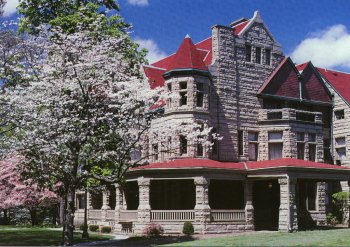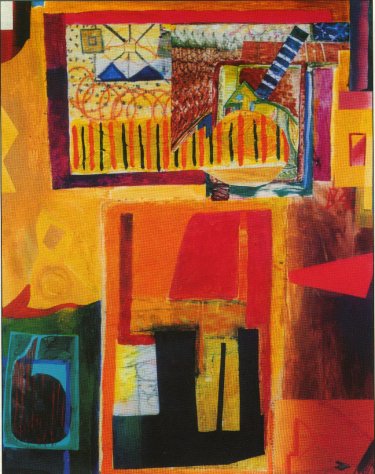FOR THE LOVE OF THE ARTS
Quincy is small. But when it comes to the arts, this little city has the guts, if not the glory, of a major metropolis
By Jennifer Davis
Quincy is lucky George M. Irwin loved to play the clarinet.
This picturesque little city on a bluff overlooking the Mississippi River is known for its historic architecture and its link to one route used by escaping slaves. Once it was Illinois' second-largest city, thanks to the river and the railroad. It's still a strong agricultural and industrial hub on Illinois' westernmost edge. An Archer Daniels Midland plant sprawls along the river near one of the area's top five employers, Gardner-Denver Machinery.
But the namesake of President John Quincy Adams also has arguably the strongest community arts scene in the state — all because the son of a wealthy local business owner returned home from college decades ago with a desire to play the clarinet.
In 1946, at age 25, Irwin started a local chamber music group. The members rehearsed in each others' homes and played wherever space was available, including church halls, the Elks Lodge or a hotel ballroom. Irwin often conducted, foreshadowing the 16 years he was volunteer conductor of the Quincy Symphony Orchestra.
In 1947, the year after he returned to Quincy, Irwin founded the nation's first arts council, the Quincy Society of Fine Arts. He says he didn't set out to break new ground. He just saw the need to coordinate the growing arts community, much of which he was helping along financially. Beginning with perhaps a dozen groups, the Society has 47 member organizations, including the Quincy China Painters and the Muddy River Opera Company. Together, those groups have 94 board members, "which means one of every 400 people in Quincy is my boss," jokes Rob Dwyer, Irwin's successor at the Quincy Society of Fine Arts. "We have 10,000 members or season subscribers in a town of 42,000.1 think you'll agree that's pretty amazing."
The arts have become a $3 million-a-year industry in Quincy. In 1990, a study by the Wolf Organization, a Massachusetts arts consulting firm, ranked that town No. 1 in the nation in per capita arts support. Last year, per capita arts support was $14.35, Dwyer figures. This compares to $1.39 per capita statewide in fiscal year 1999, according to the National Assembly of States' Arts Agencies.
This year, Quincy, which has received four national awards, including one from Arts Management magazine, and is in the running for another, was the only city in Illinois or Missouri to be listed in the book, The 100 Best Small Art Towns in America. And just last month, Quincy Newspapers Inc. was awarded one of three 1999 Governor's Awards for the Arts for its ongoing, longtime corporate support.
Overall, the theme is dedicated, grass-roots, if somewhat amateurish, support. Celebrity means little. Nobody can name a full-time professional actor who has graced a Quincy stage. But many can recall that the mayor's brother, assistant city attorney Christopher Scholz, played Daddy Warbucks in last November's production of Annie.
"I tell people, 'If you want to see Hamlet, go to Chicago. If you want to be Hamlet, come to Quincy,'" says Dwyer.
People do.
Quincy Community Theatre's performers may travel upwards of 50 miles one way for the chance to play the cowardly lion in the Wizard of Oz, as does Dan Tucker, a Mt. Sterling agricultural financial consultant. Besides Mt. Sterling, they come from Hannibal, Mo., Keokuk, Iowa, and smaller towns in between.
Quincy Community Theatre has nearly 3,000 season ticket subscribers who live in 53 cities and towns in the tri-state area, including state Sen. Laura Kent Donahue, a Quincy Republican, and Rep. Art Tenhouse,
30 December 1999 / Illinois Issues

The Newcomb-Stillwell Mansion, built in 1891, is listed on the National Register of Historic Places. The Romanesque Revival style building is now home to the Quincy Museum of Natural History and Art.
a Republican from Liberty
Season tickets are something "a lot of community theaters don't even bother with," says Barbara Rowell, managing artistic director of the company since 1983.
Ten years ago, Quincy Community Theatre grew out of its 216-seat church hall, a result of "having to do 14 performances of a show."
"We set a pretty high standard for ourselves and now people expect it, Rowell says.
In 1995, with some major state grant help, Rowell moved her seven full-time staff into a 498-seat, $3.25 million theater in the city's new Civic Center, literally just four blocks off Broadway "We joke about that a lot,'' she says.
Hers is not the only arts-related expansion in recent history. In 1990, the community privately raised $600,000 for a big new wing at the Quincy Arts Center, a modern gallery incorporated into the Victorian-era carriage house that has been the center's home since the 1930s.
And because the 2,012-seat junior high school theater, with its beautiful Art Deco interior, is heavily booked with symphonies and dance recitals, there are ongoing talks between the city and Quincy University about the possibility of renovating the old Washington Theater just off the downtown square.
"We have to make our own entertainment, I guess," says Rowell, attempting to explain just why this somewhat removed community is so heavily involved in the arts.
Illinois Issues December 1999 / 31

This untitled abstract, mixed media work by Jason Dillard Mejer, is this year's Best of Show winner in the annual Mary S. Oakley Area Artists Showcase competition in Quincy. This work, and others in the showcase, are on display at the Quincy Art Center until December 17.
32 / December 1999 Illinois Issues
|
A quick jaunt into Chicago or St. Louis — or even Peoria or Springfield — isn't always possible.
Most also give credit to Irwin. His cash came from his family, but he says his passion came from a strong public school music education.
Today, the society he founded makes arts education a top priority, ensuring that Quincy's students will likely be more open and supportive of the arts in the future. In 1983, the Quincy Society of Fine Arts served 3,250 Adams County students through its outreach programs. This year, that number was 19,250.
Irwin's legacy has been in place so long that it's somewhat taken for granted by those who live in Quincy After founding the local art society, Irwin became the father of the Illinois Arts Council and, in 1969, the administration of former President Richard Nixon asked him to chair the National Endowment for the Arts. He declined. He simply didn't want to leave Quincy and all he had started and nurtured.
Irwin is pretty nonchalant, modestly talking about how Gov. Otto Kerner called in 1963 to ask him to chair a committee to develop a statewide arts council, one of only five nationwide that existed before the NEA. Kerner had read about Irwin in a New York Times article that noted his work in creating the first national private arts advocacy group. Many name changes later, it's known as Americans for the Arts.
It's taken a transplant like Dwyer, who comes from Oregon, to draw attention to the gems in Quincy, the Gem City. Most Quincy natives likely don't recall life before Rowell's theater or the community concert band. ž
Jennifer Davis is a reporter for the Peoria Journal Star and a former statehouse bureau chief for Illinois Issues.
|
Illinois orchestrators
It was a little girl born on an Osage Indian reservation in 1925 who would grow up to become the first American-trained ballerina of international importance and the founder of the Chicago City Ballet. Maria Tallchief began studying dance at the age of 7 in Los Angeles. At 17, she joined the Ballet Russe Monte Carlo in New York, quickly attaining the status of prima ballerina and catching the attention of renowned choreographer George Balanchine. After he formed the New York City Ballet, Tallchief joined the company Her ethereal presence in Firebird established her reputation. She became the artistic director of the Chicago Lyric Opera Ballet. Then, in 1981, she founded the Chicago ballet company, where she served as artistic director. In 1996, Tallchief was recognized by the Kennedy Center for her contributions as a performer, teacher and director.
Hungarian-born conductor Georg Solti began an enduring relationship with the Chicago Symphony by directing the orchestra at the Ravinia Festival in 1954. Solti returned to Chicago for good in 1969 as the Chicago orchestra's musical director. He would remain in that position until 1991. During his 22-year tenure, Solti, who died in 1997 at the age of 85, is credited with enhancing the repertoire of the orchestra and extending its worldwide reputation. In 1971, the orchestra, directed by Solti, embarked on its first overseas tour, exposing the world to his signature sound, a brilliant sweep of brass. Under Solti's leadership, the orchestra built a reputation for excellence in recording. His work garnered 23 Grammy awards. And in 1996, he was presented with a Grammy for lifetime achievement in the recording industry.
The Steppenwolf Theatre Company was born in the basement of the Immaculate Conception Church in Highland Park, where the troupe began performing informally in 1974. Over its 30-year run, Steppenwolf has achieved national and international recognition. The founding members, Terry Kinney, Jeff Perry and Gary Sinise, sought to develop a dynamic environment for innovative artistic expression. The company expanded its membership to include the likes of John Malkovich and Joan Allen. A landmark for the group was its staging of John Steinbeck's The Grapes of Wrath. In 1998, the company received the National Medal of Arts for its contribution to theater.
The Editors
|
Illinois Issues December 1999 / 33

